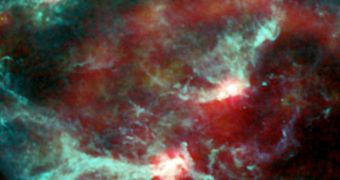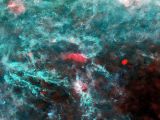Launched together with the Herschel Space Observatory, the Planck Telescope is one of the European Space Agency's (ESA) most prized possessions, and the most advanced and sensitive scientific instrument of its type. It was deployed to study the Cosmic Microwave Background (CMB), the remnant radiation that was left behind after the Big Bang, and which permeates the Universe ever since. The telescope is also capable of producing amazing data in infrared wavelengths, and new observations made public by ESA show the Milky Way in previously-unseen colors.
The secret to Planck's amazing sensitivity is its multi-frequency observations ability. It can look at the interstellar medium (ISM), the agglomeration of gas and dust that exists between stars, and resolve a host of obscured physical process that governs the way stars are formed inside stellar nurseries. When trying to observe these phenomena in visible light, experts usually hit a block. Small dust particles located in cosmic gas prevent these wavelengths from peering into nebulae, where massive stars form deep inside cocoons of dust and hydrogen gas.
In the new images ESA made available, the “scenery” changes completely when viewed with Planck. The dust can no longer block these longer wavelengths of light, and the interiors of star-forming regions suddenly become visible. In the range of frequencies that the telescope is especially-well equipped to observe, the Milky Way emits strongly over important swaths of the sky, the team managing the observatory says. This allows the instruments on Planck to map the distribution of the interstellar dust with great accuracy and precision.
“Precise measurements of the Cosmic Microwave Background are crucial to cosmology, and to understanding how our Universe formed and evolved. Attaining the highest-sensitivity (a few parts per million), highest-angular resolution (5 arcminutes) maps of the CMB – the goal of the Planck mission – requires the removal of the 'foreground' emission arising from the Milky Way. The information gleaned during this process is providing, as a by-product, a unique view of the processes that led to the formation of the stars in the galaxies that populate our Universe,” ESA officials write in a press release.
Planck maps the sky in nine frequencies using two state-of-the-art instruments, designed to produce high-sensitivity, multi-frequency measurements of the diffuse sky radiation: the High Frequency Instrument (HFI) includes the frequency bands 100 – 857 GHz, and the Low Frequency Instrument (LFI) includes the frequency bands 30-70 GHz. The first Planck all-sky survey began in August 2009 and is 98% complete (as of mid-March 2010).

 14 DAY TRIAL //
14 DAY TRIAL // 
